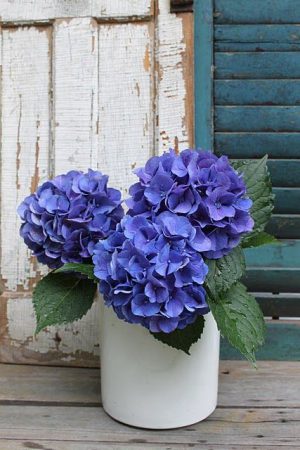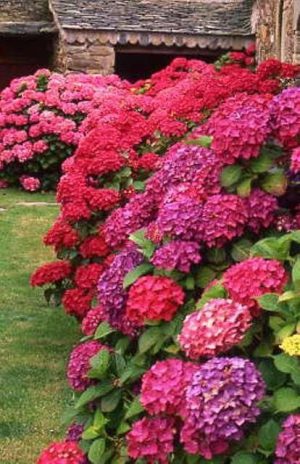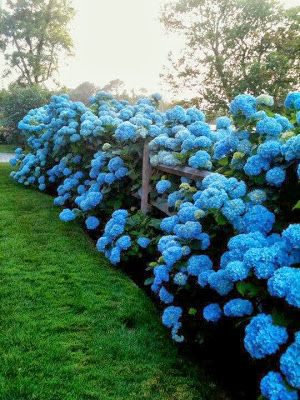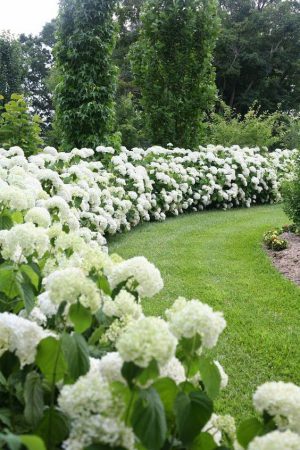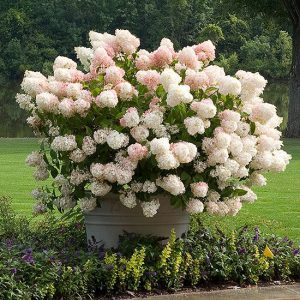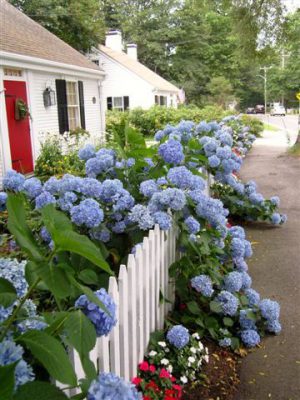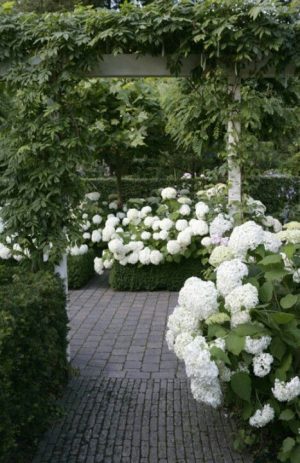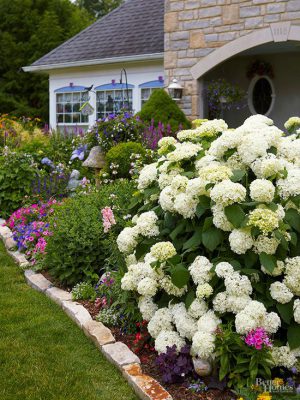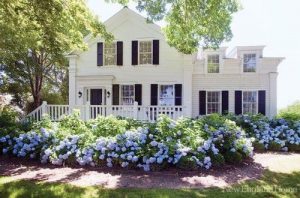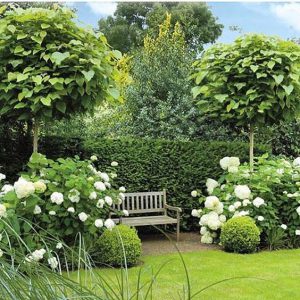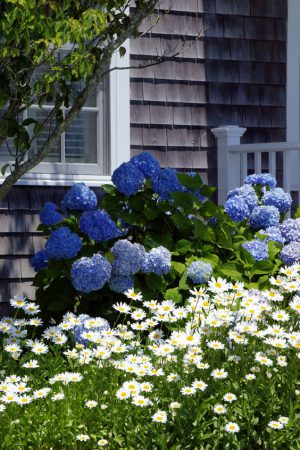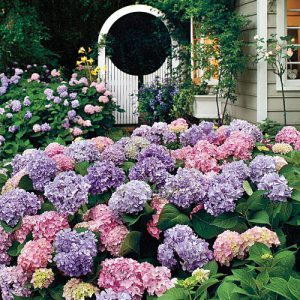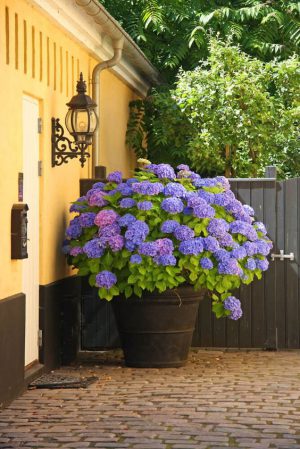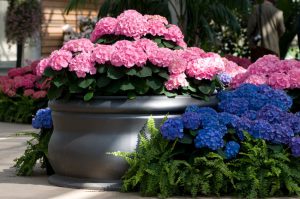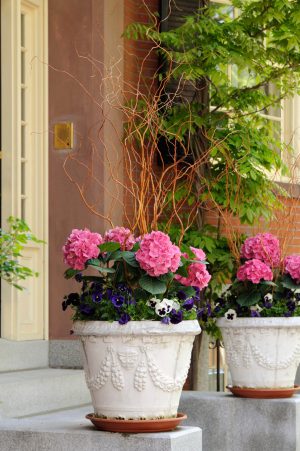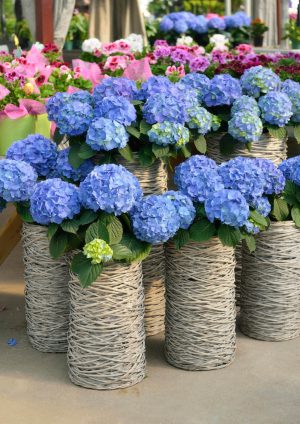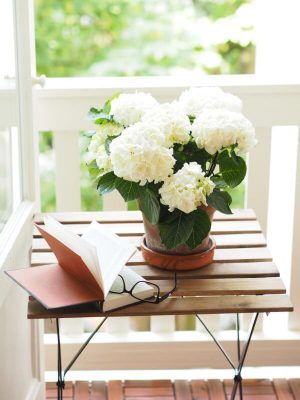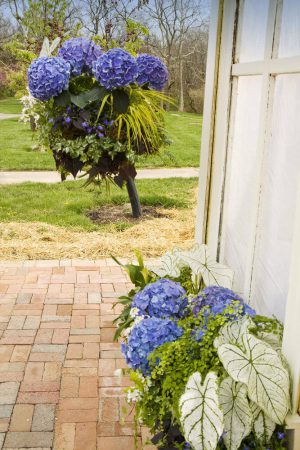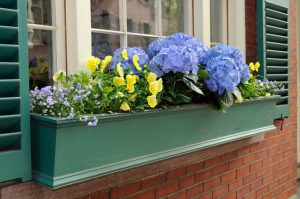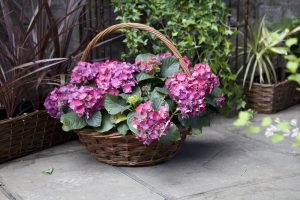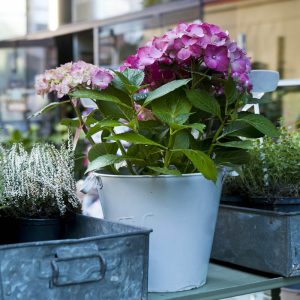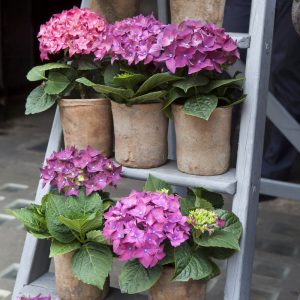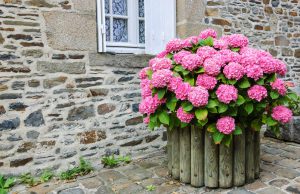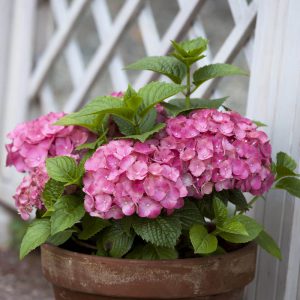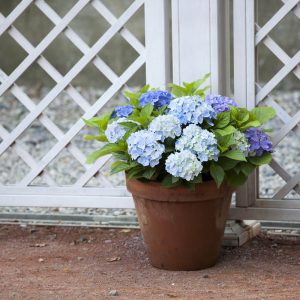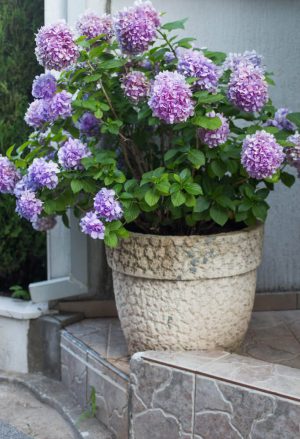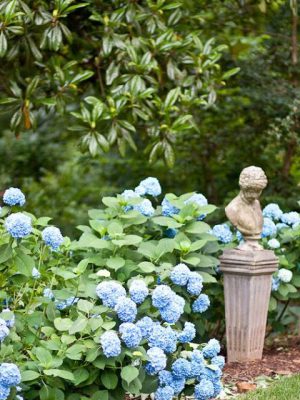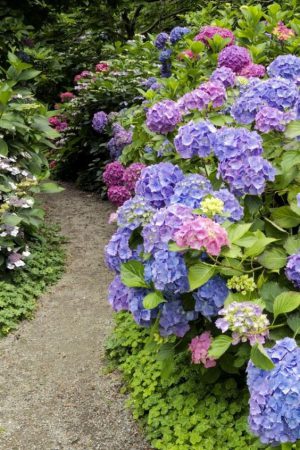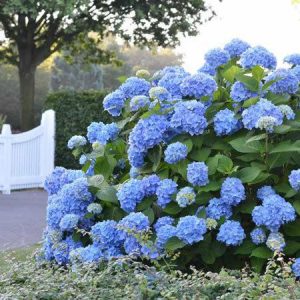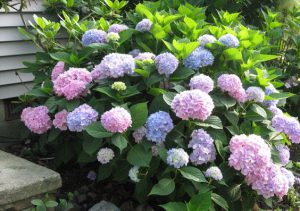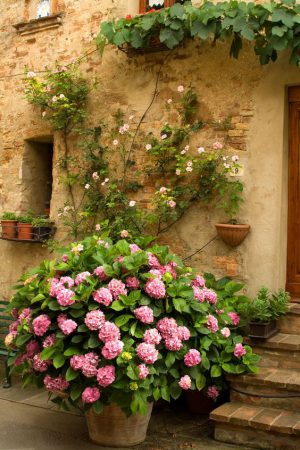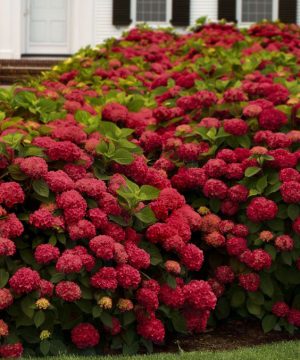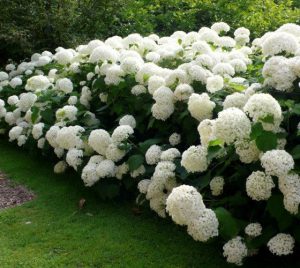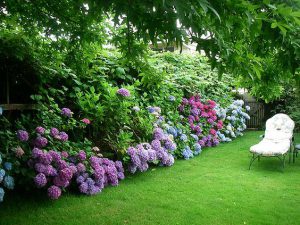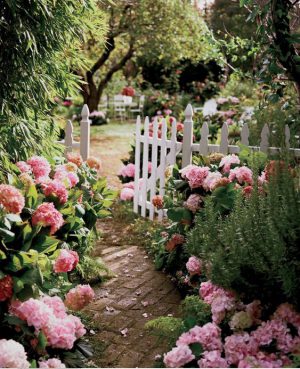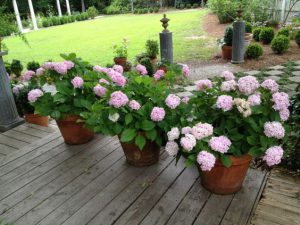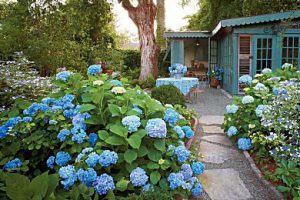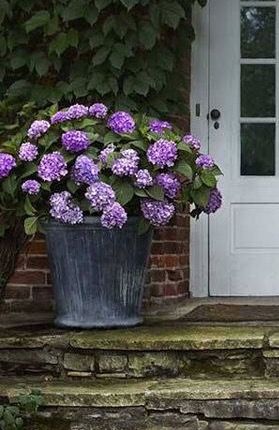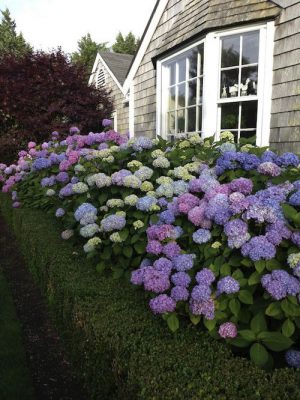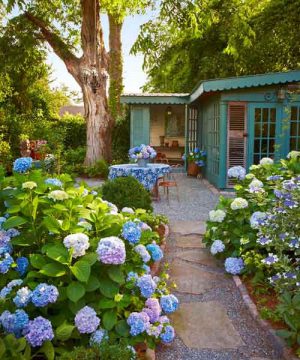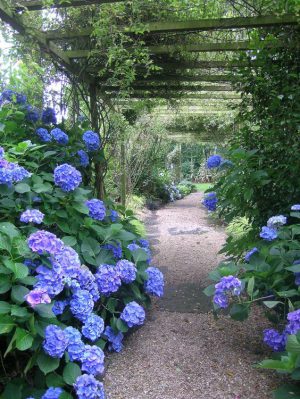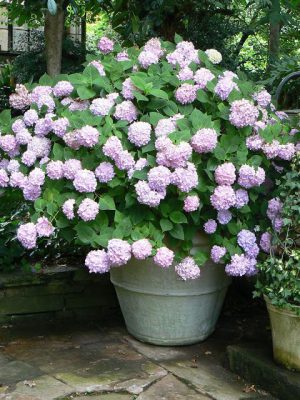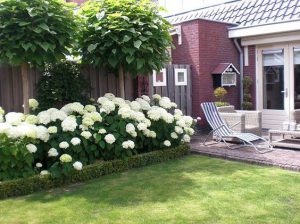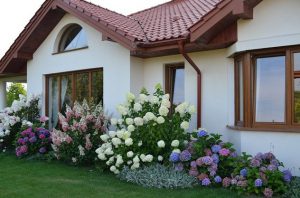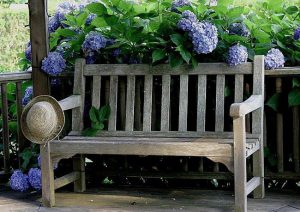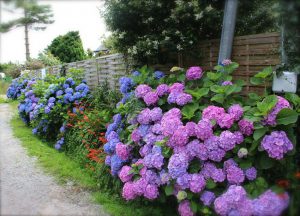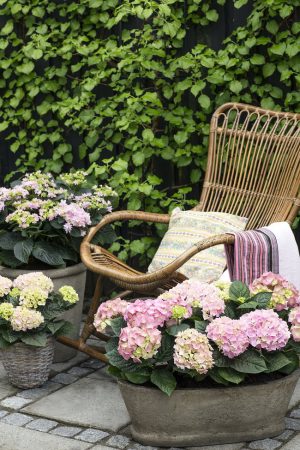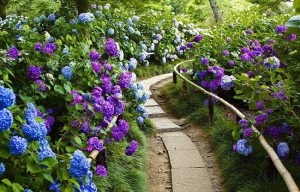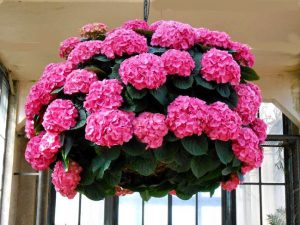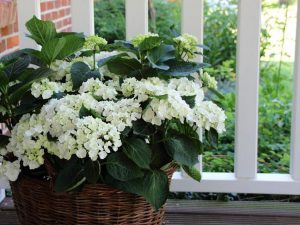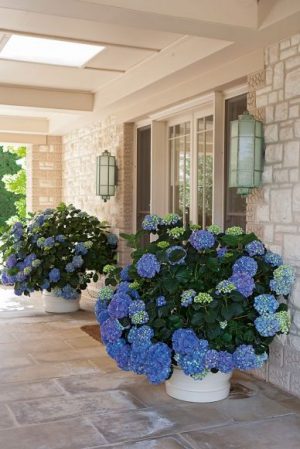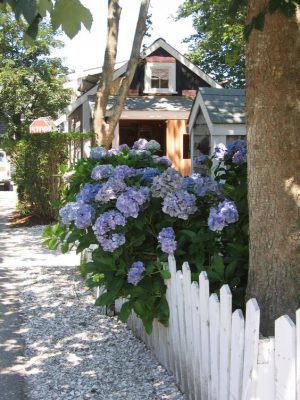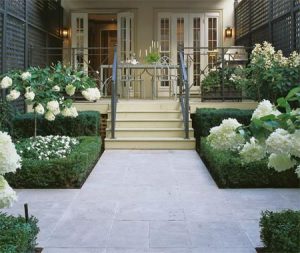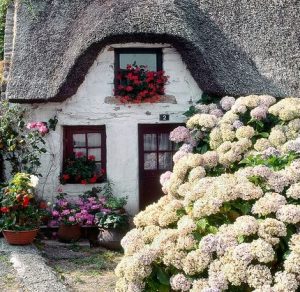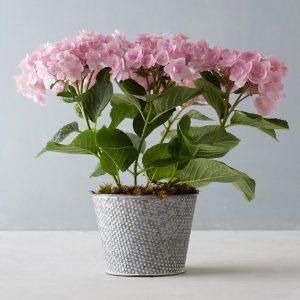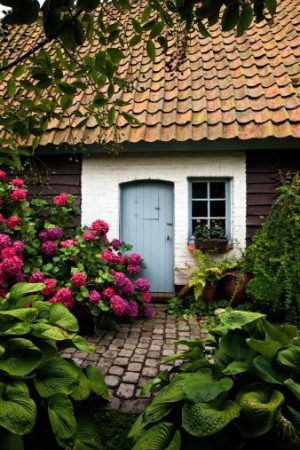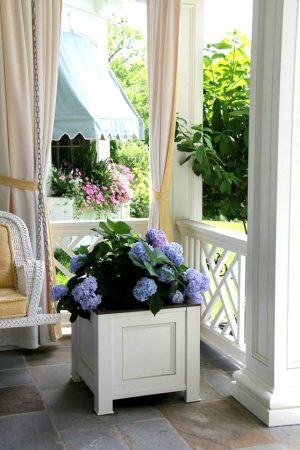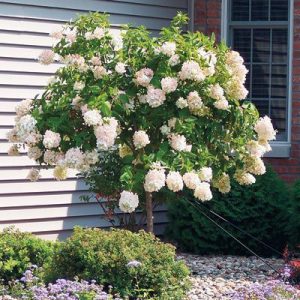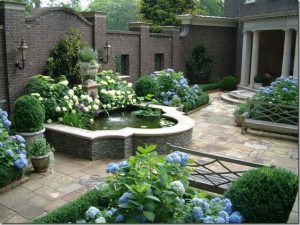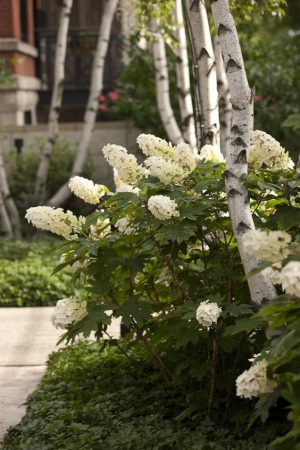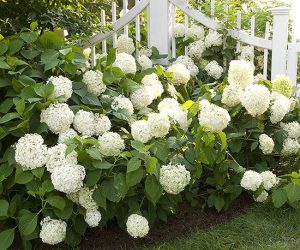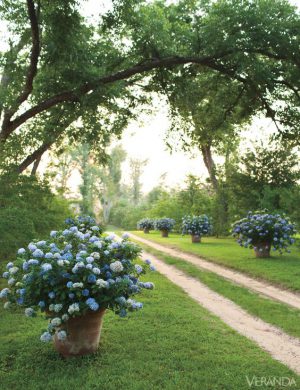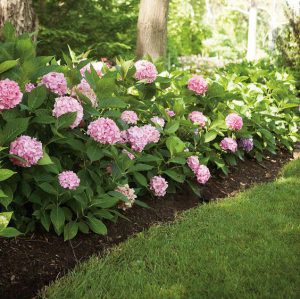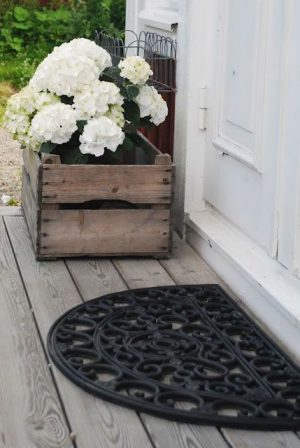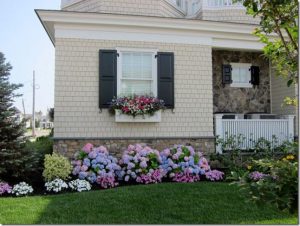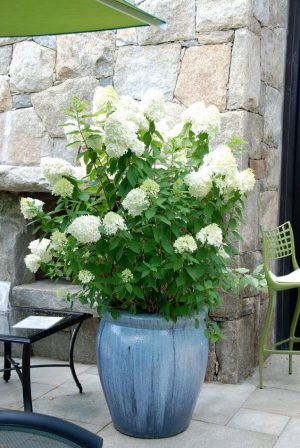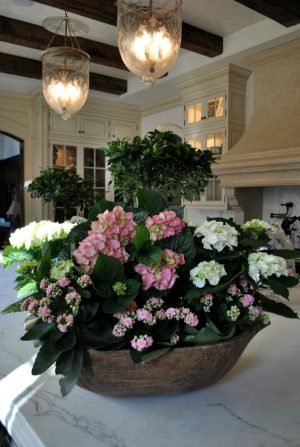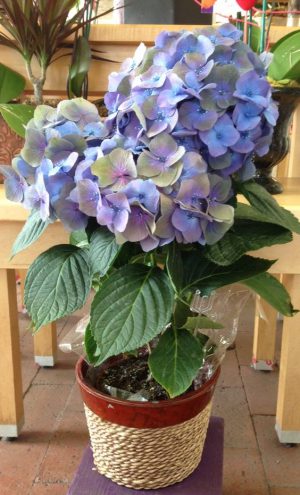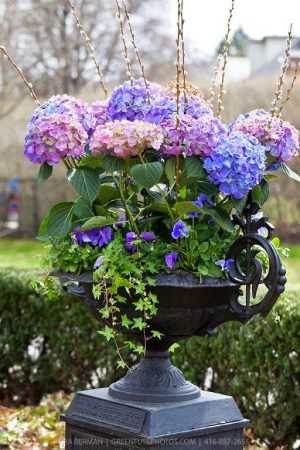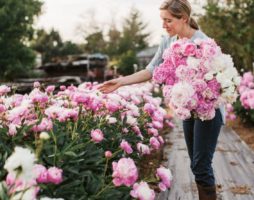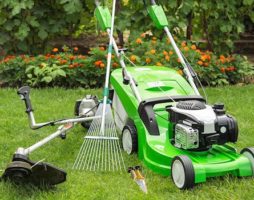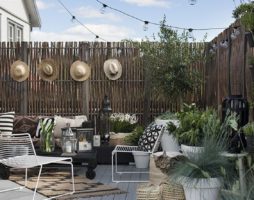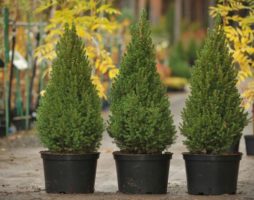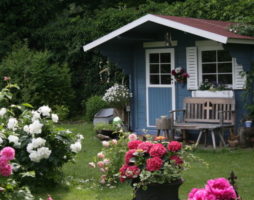Hydrangea is a luxurious perennial shrub, the joy of flower growers and landscape designers. This is a real miracle of nature, the beauty of which is truly mesmerizing. The lush flowers of the plant, with appropriate care, will delight the eye for almost the entire summer-autumn season.
Exotic exterior
The hydrangea bush is covered with ovoid bright leaves. Flowers are formed into spherical, stuffed, dense inflorescences. Their plant throws out at the ends of the shoots. Flowers can have a variety of colors. Most often you can see them in green, blue, pinkish and white versions.

Bright hydrangea bushes
In the Hortensia family, several dozen subspecies of this plant are collected. They may look like:
1. Shrubs.
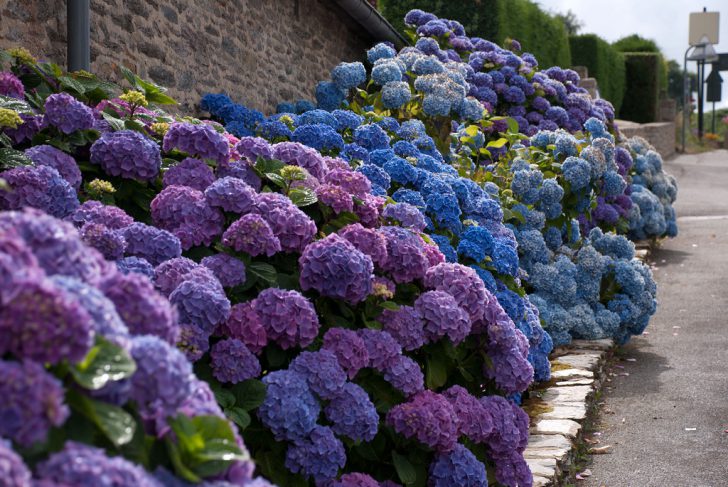
Bush hydrangea
2. Semi-shrubs.
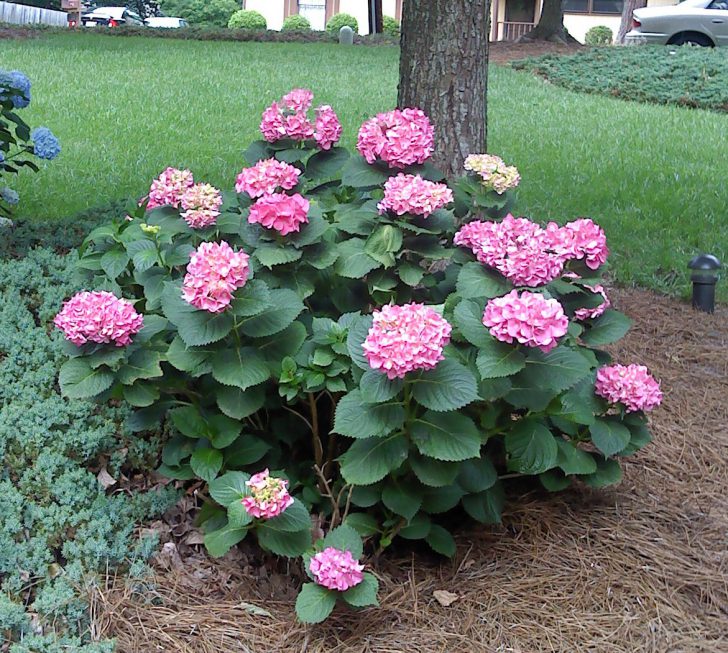
Hydrangea in the form of a shrub
3. Lianas.

Bright hydrangea liana
4. Tree-like individuals.

tree hydrangea
The majority of representatives are deciduous species. Hydrangea is not only a plant of gardens, the flower grows well at home, but the rules for caring for it in this case are somewhat different.

home hydrangea
Hydrangea breeding methods
It is difficult to get fed up with beauty, therefore, after the first acquaintance with hydrangea, you will certainly want to see it in your garden in different interpretations. There are three ways of reproduction of each species. The plant can be grown from seeds, cuttings or by dividing the bush.

hydrangea seeds
If you are going to use seeds, then they should be planted in the ground in the month of May. From the moment of emergence of seedlings to the first flowering, you will have to wait two years.

Hydrangea sprouts
When dividing the bush, this process is greatly accelerated. If you plant it in the spring, then by the autumn the new seedlings will be completely stronger and will delight you with lush flowering in the next season.
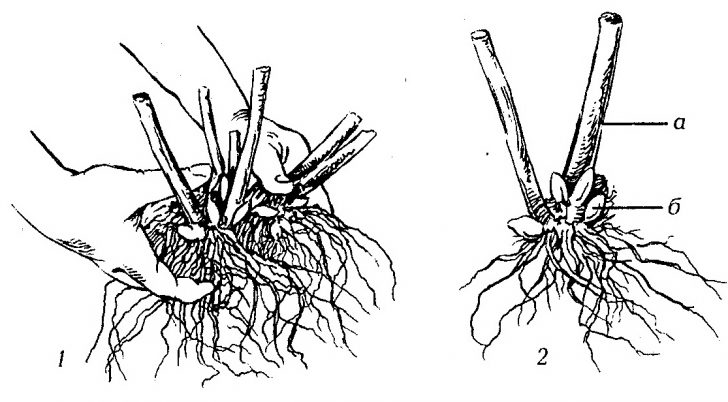
Propagation of a hydrangea bush by division
Only young first-year shoots are suitable for cuttings. They quickly take root, literally in 20 days and begin to actively develop into a bush.

Hydrangea cuttings
Ground and planting details
“The plant is photophilous, but it does not react well to direct sun, so look for places to plant it where there will be partial shade at noon”
You can plant hydrangea seedlings at any time, from the end of April to late autumn. Even in the summer, this is not prohibited. The only recommendations on this issue is the need to purchase young bushes in pots or tubs. Such a long landing period, of course, pleases, however, spring still remains the optimal time for such work.

Planting hydrangeas in the ground
The plant is photophilous, but it does not respond well to direct sun, so look for places to plant it where there will be partial shade at noon.
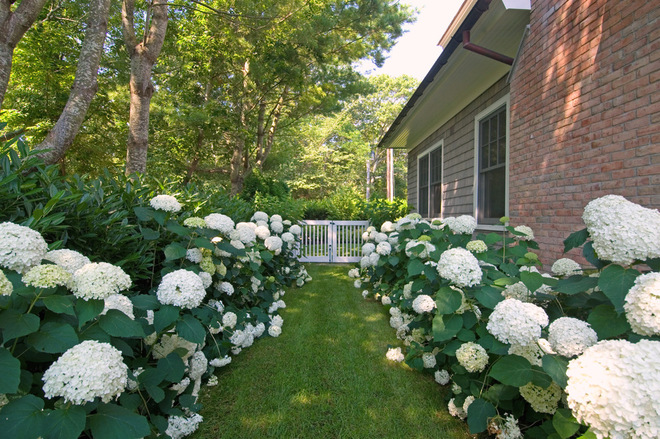
The optimal place for planting hydrangeas is partial shade
In the landing zone, a special soil regime will have to be created. A soil that gives an acidic reaction is welcome. In order to create a similar soil effect, peat is laid in the planting pits or soil mixture suitable for azaleas is poured. Mixtures of leaf humus and compost, mixed in equal parts, can be used for this purpose.

Hydrangea loves acidic soils
Compost can be replaced by:
1. Superphosphate.
2. Potassium sulfate.
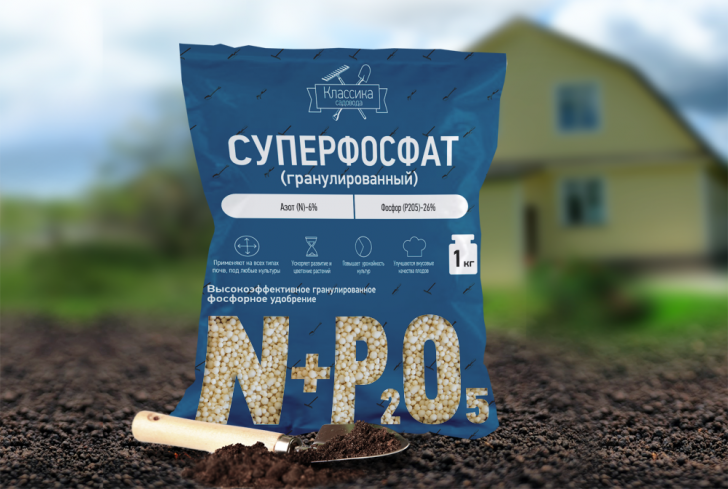
Compost can be replaced with superphosphate
It is necessary to prepare the soil in other ways as well. The soil should be permeable and loose, then the seedling will not have difficulty breathing.
To plant a shoot, you will need to make a hole twenty-five centimeters deep, lay one of the above feeding options on the bottom and, inserting a bush there, slowly fill the hole with a bucket of warm water. The pre-cut root should be in the mule. After that, the hole is covered with dry earth, which is somewhat trampled around the process.
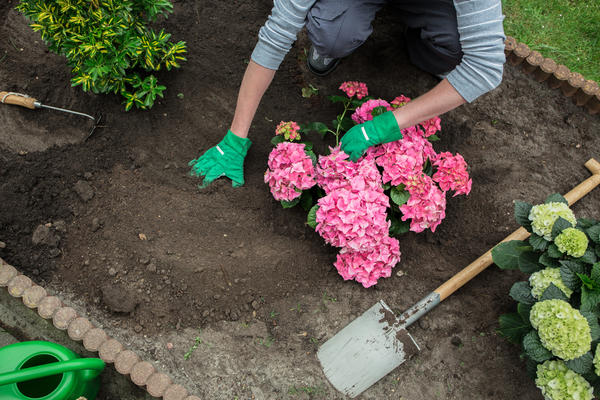
Planting hydrangeas
To maintain an optimal microclimate in the upper layers of the earth, it is mulched. For this use:
1. sawdust.
2. Paper.
3. Burlap.
4. Needles.
5. Straw.
6. Expanded clay.
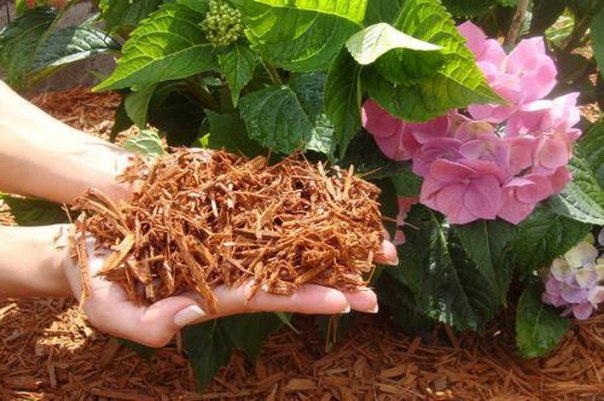
Mulching hydrangeas
Mulching will protect the hydrangea roots from overheating, slow down the growth of weeds. Organic mulch placed around a shrub will begin to decompose over time and become part of the local soil, slightly acidifying its pH, which is very beneficial for the plant.

Mulching will protect the soil from moisture loss.
In general, in the future, the mulching process will be carried out in late spring, when the soil has already warmed up well, but has not yet had time to dry out, and in late autumn, with the onset of a period of light but steady frosts. Mulching material is covered along the perimeter corresponding to the projection of the crown of a single plant or the entire landscape group. It is possible to expand the boundaries of mulching by 20 centimeters. This will have a positive effect.
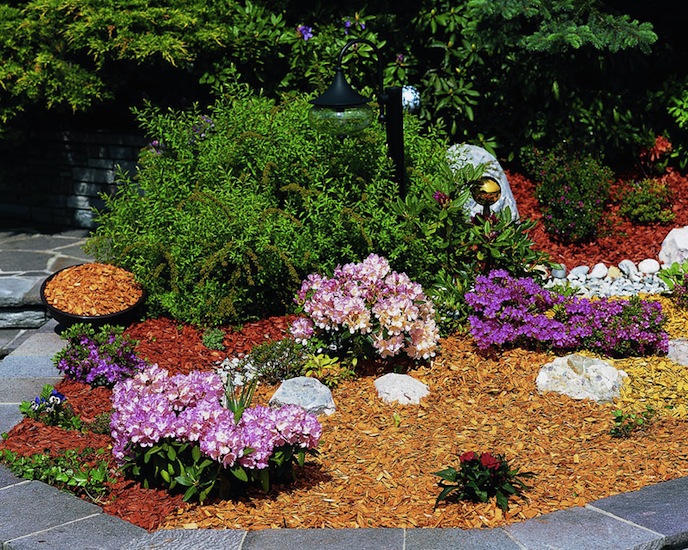
Mulching is carried out along the perimeter of the landscape group
If the hydrangea is planned to be grown as a hedge, then at least a two-meter distance must be left between the seedlings. This will help to ensure that the bushes do not "suffocate" each other after growth.
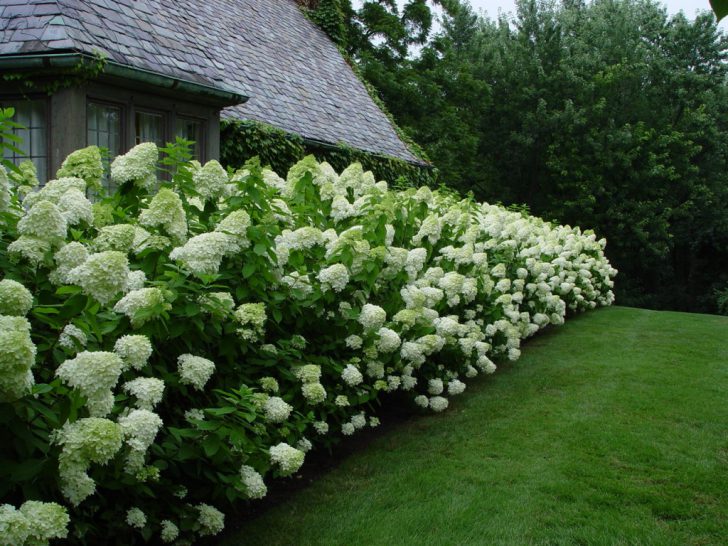
hydrangea hedge
Watering garden hydrangeas
Hydrangea loves moisture, so the watering schedule should include this procedure at least twice a week. Weekly water consumption for each bush - 20 liters. In hot weather, the bushes are mulched with straw or sand to prevent the roots from drying out.
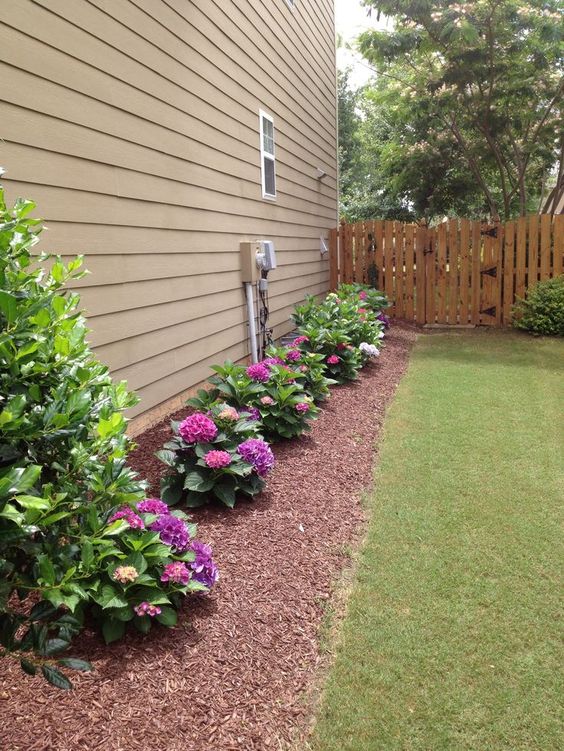
Mulching will keep the hydrangea roots from losing moisture.
Top dressing of hydrangea growing in open ground
In order to develop normally, bloom luxuriantly and lay a sufficient number of flower buds for the next season, hydrangeas need strength, and they are given to the plant by fertilizers. They should be rich in magnesium and contain iron. Plants are fertilized both during the planting period and during intensive growth. The first portion of hydrangea is given in the first days of summer. It can be a solution of bird droppings or balanced complexes of minerals. In the future, the procedure is repeated at intervals of two weeks. The feeding of the plant stops at the end of July, because the hydrangea shoots should have time to stiffen by the onset of cold weather.
back to index ↑pruning
This process regulates the size and number of inflorescences and is carried out every year. On pruned bushes, fewer inflorescences form, but they become noticeably larger. Since only the shoots of the current year are peduncles, they will need to be cut off very early in the spring. For mature and strong plants, shoots are shortened by ¾, keeping no more than three pairs of buds. At the same time, weak and frozen branches are cut out during the winter. In the fall, you will also have to pick up a sharp pruner, but now only faded inflorescences will be removed.
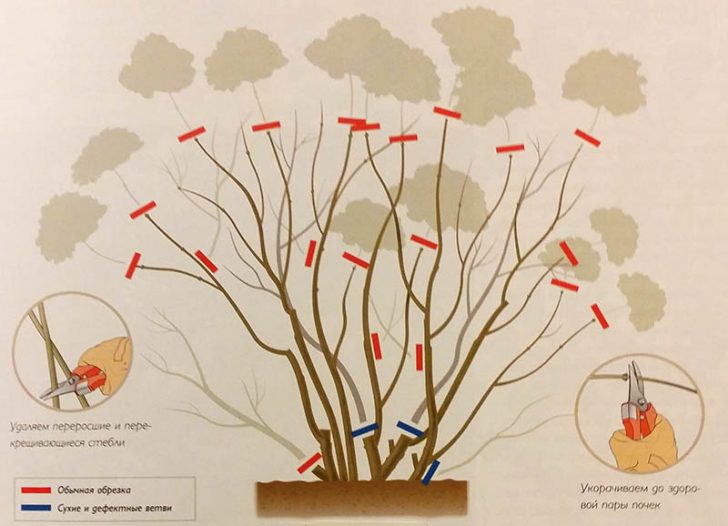
Hydrangea pruning scheme
wintering hydrangeas
If the hydrangea varieties you have planted are not frost-resistant enough or the bushes are simply too young, the plants need to organize a comfortable wintering. The easiest way to do this is to mulch the near-stem circle of the shrub with spruce branches, a thick layer of peat or sawdust. You can use straw and just fallen leaves. Thus, tree-like types of hydrangeas are protected. Mulching is done in dry weather. The signal to start work is the first frost.
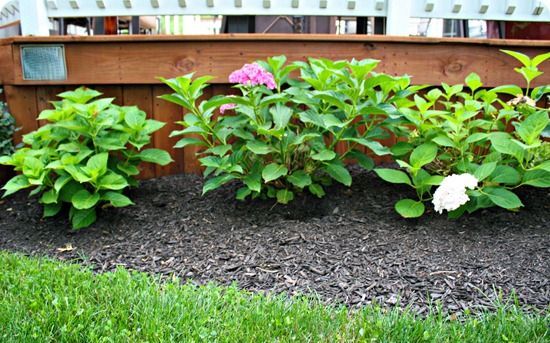
For a comfortable wintering of hydrangeas, mulch the soil
Heat-loving varieties such as petiolate hydrangea, large-leaved, are carefully bent down in late autumn, laying on the ground, covered with boards or spruce branches, and fixed in this position with special hooks. From above, the plant is sprinkled with fallen leaves or spruce paws.
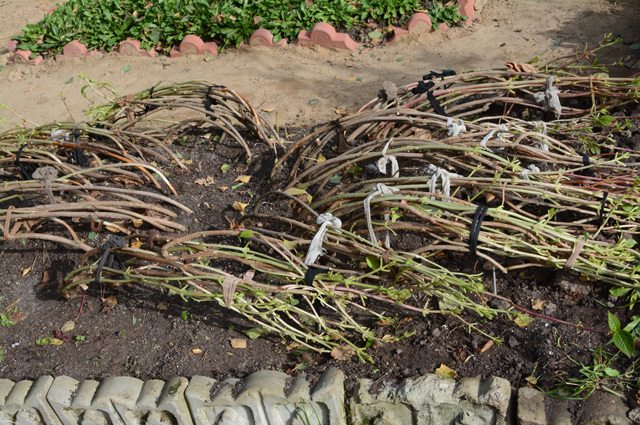
Preparation of hydrangeas for wintering
In varieties with stiff shoots, the crown is saved as follows. It is wrapped with any covering material such as lutrasil, spunbond or kraft paper and tied. Mulch and winter sarcophagus are removed from plants as soon as danger of frost has passed. This period usually falls in mid-April. It is necessary to approach the process correctly so that the plants do not suffer. Work is carried out on a cloudy day, in the evening, so that the active spring sun does not burn the shoots.
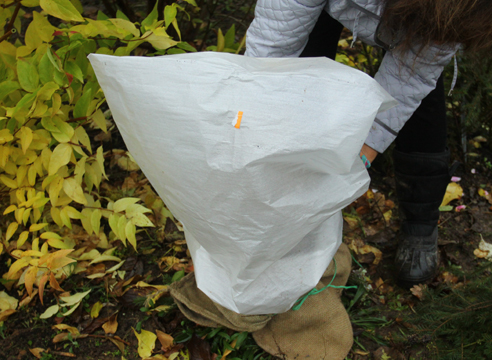
How to shelter hydrangeas for the winter
And one more subtlety of caring for garden hydrangeas. Their flower garlands look great, but as soon as the rain passes, they absorb moisture and become too heavy for the branches holding them. So that the latter do not break, the bushes are recommended to be tied.
back to index ↑decorative hydrangea
At home, large-leaved hydrangea is mainly grown. Its flowers also have a variety of colors.
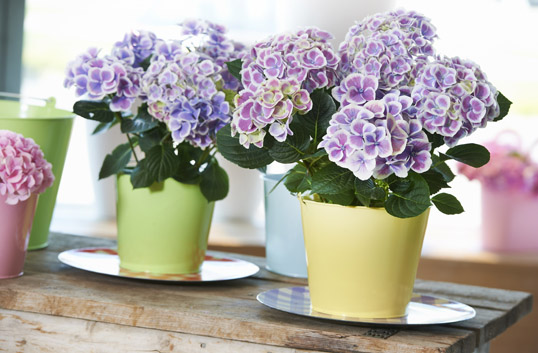
home hydrangea
The flowering period is no less long than that of garden species, in winter the plant needs rest. He needs this time to gain new strength for the new season of active life. Growing a flower is not too difficult. But there are some subtleties in this matter.
Lighting
Well-groomed plants will thank their owners for a long and lush flowering. A pot of hydrangea should be placed in a well-lit place, but in one where the burning rays of the sun do not reach.
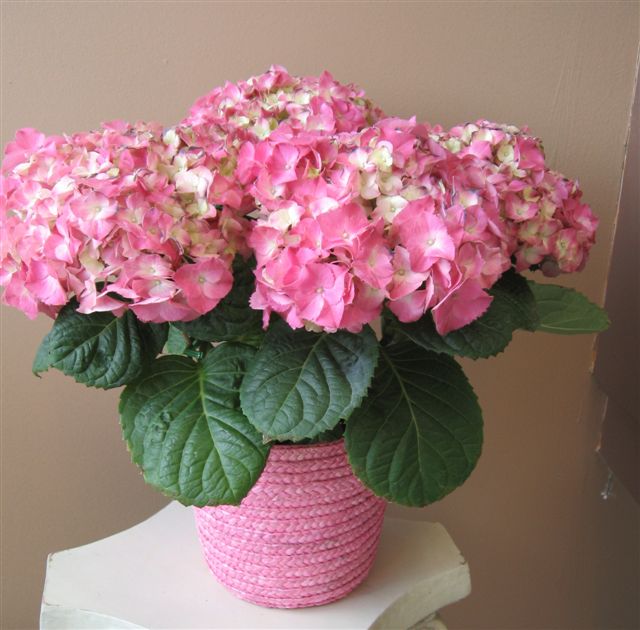
Hydrangea prefers well-lit places
By placing a flower on the windowsill, you are guaranteed to provoke the appearance of light spots on the leaves, but overly shaded corners are not for him. Best of all, the plant will feel at a distance of three meters from the window.
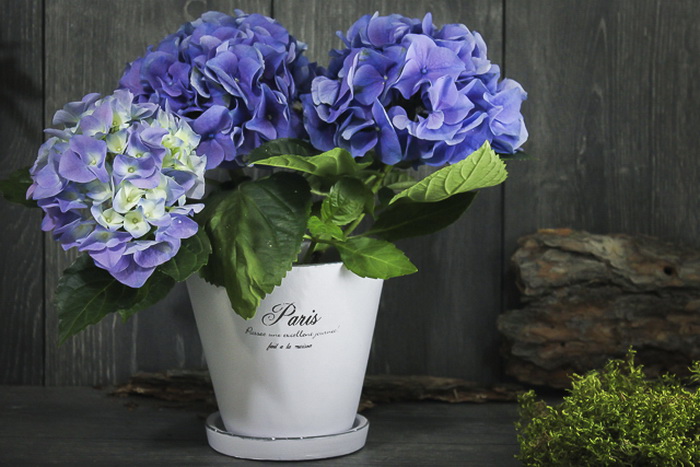
Keep hydrangeas out of direct sunlight
Temperature regime
Hydrangea does not like drafts and can die with sudden temperature changes, although, in principle, the indoor microclimate, where it does not go lower than 18o, is quite appealing to her.
For wintering, the plant should be identified in a darkened and cooler place, for example, in the basement, where it is possible to maintain + 7o. Don't forget to water your hydrangea. Naturally, this is done much less frequently than in the active phase, but, nevertheless, periodic watering is necessary. February is the month of the hydrangea awakening, so it's time to bring it back into the room. If you ignore this rule and do not create a "winter vacation" for the flower, it will bloom only next winter.
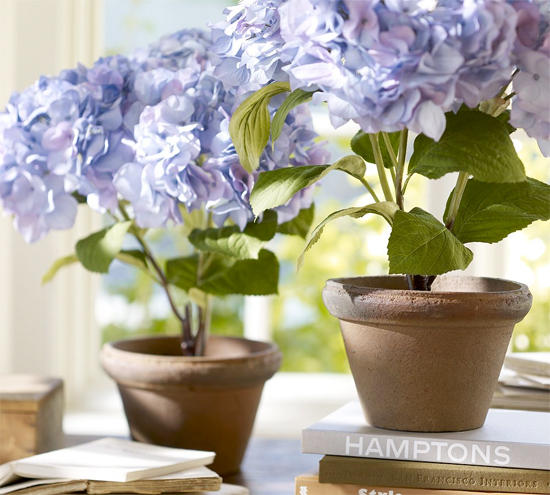
For the winter, move the hydrangea to a dark place
Irrigation Features
“You need to water the hydrangea with settled water, warmed to room temperature”
Hydrangea was awarded another name - hydrangea, the translation of which sounds like "amphora with water." This very accurately describes how much the plant loves moisture.
Home hydrangeas need balanced watering. In the summer, the plant is poured abundantly, and this is done regularly, every two days, but the spring-autumn season is a time of moderation in everything, including watering.In winter, during sleep, the plant is given a minimum of moisture, taking care that its roots do not rot.
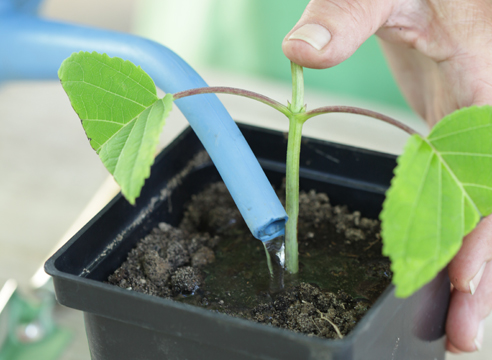
Hydrangea needs regular watering
Hydrangea should be watered with settled water, warmed to room temperature. Melt water or rain water is suitable for these purposes. Sometimes it will not be superfluous to add a little lemon juice to the irrigation water at the rate of 5 drops per liter. The lack of soil acidity will affect the color of the leaves, which may turn yellow.
Likes hydrangea and sprays. Dry air is forced to dry out the edges of the leaves. For this reason, the flower is not placed close to the batteries.
top dressing
The plant is fed during flowering. A lack of nutrients will slow down the development of hydrangeas and push back the flowering cycle. In winter, it is not worth feeding a dormant plant. It is not ready to assimilate "food" even in minimal quantities. If you want to increase the beauty of the buds and color of the hydrangea, you can spray it with a solution of gibberellin.

Gibberellin solution will enhance the beauty of flowers
Transplantation
This process is annual and takes place in the fall. Need a transplant to stimulate the flowering process next season. An earth mixture consisting of sand, peat, soddy soil, leafy soil is poured into the pot, and good drainage is required. Hydrangea grows best in wide pots because its root system develops in a horizontal plane. Going for a new pot, remember that it should be one and a half times larger than the old one.
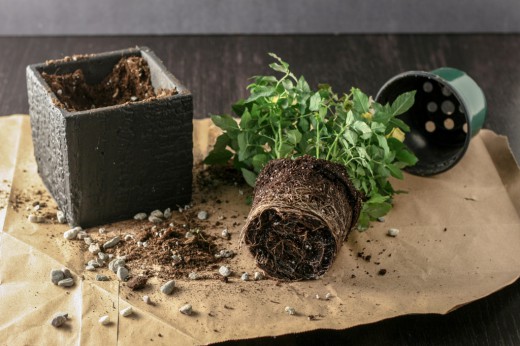
Hydrangea needs an annual transplant
The uniqueness of the hydrangea
The plant has an unusual ability to accumulate aluminum. Flower growers have learned to use this quality to change the color of the petals. It is worth adding lime to the soil of the pot, as the flowers turn pink. If you want to see them blue, add aluminum sulfate, aluminum alum to the soil, or spray the plant with aluminum citrate.
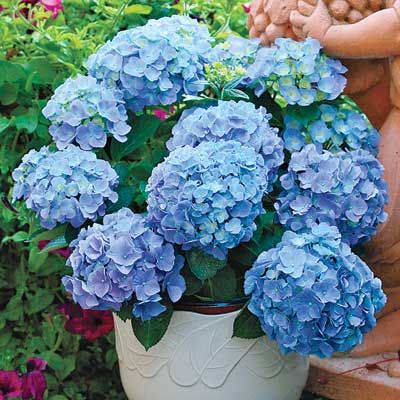
To make hydrangea flowers have a blue color, spray it with aluminum citrate
Reproduction at home
Hydrangea can be propagated by cuttings and dividing the bush. The cuttings are the lower parts or tops of young shoots, and it is recommended to break them off, and not carefully cut them off. The damaged part of the shoot is treated with Kornevin, after which it is planted in moistened sand and creates the effect of a greenhouse. The role of a "greenhouse" can be performed by an ordinary glass jar.
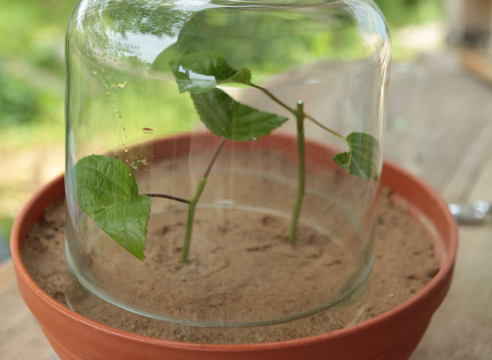
Reproduction of home hydrangea
Bush formation
In order for the hydrangea to have a presentable appearance, it must be cut correctly. It is necessary to get rid of weak shoots, cut off the tops of normal shoots. The latter will open the way for the growth of additional shoots. Thus, a luxurious bush is gradually formed.
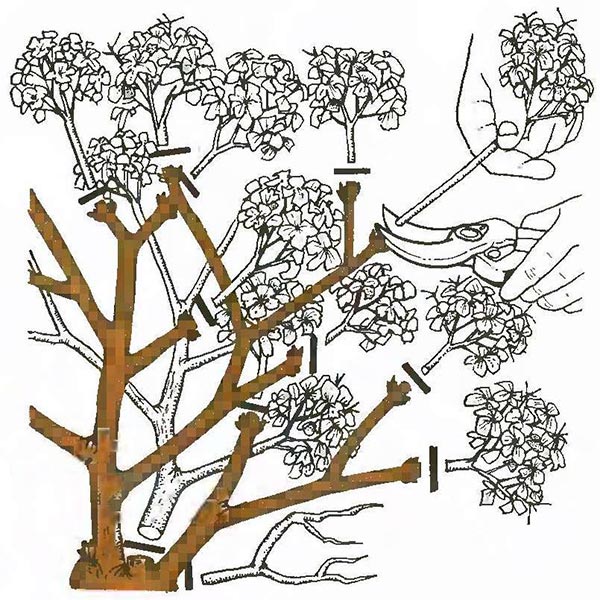
Formation of a hydrangea bush
Pests
Hydrangea can suffer from the invasion of spider mites, aphids, stem nematodes. The first one does not tolerate ordinary water spraying, the second one is easy to overcome with Actellik solutions, but nematodes are invincible and when attacked, the plant will simply have to be thrown away.
back to index ↑Conclusion
As you can see, such beauty as hydrangea does not require special sacrifices from you when breeding and maintaining it, so there is no reason to deny yourself the pleasure of enjoying its aesthetic appearance.
Photo gallery - hydrangea
Video
